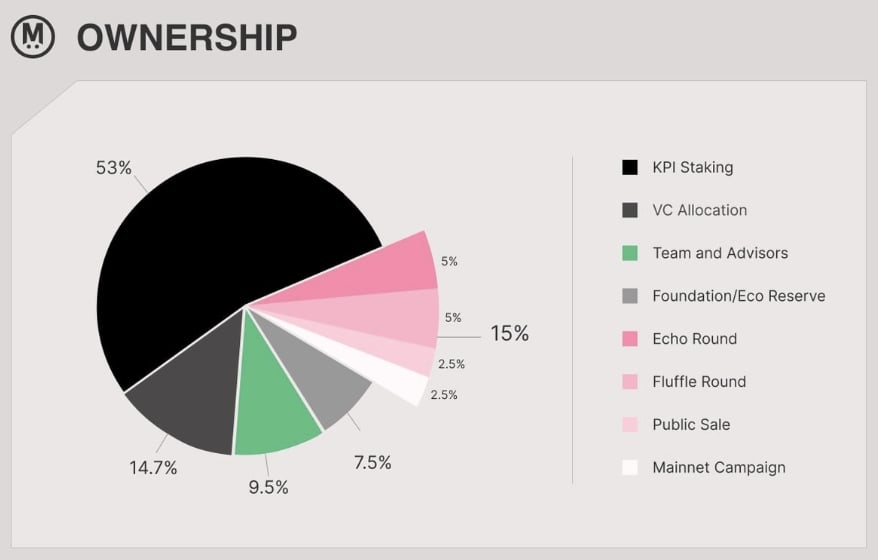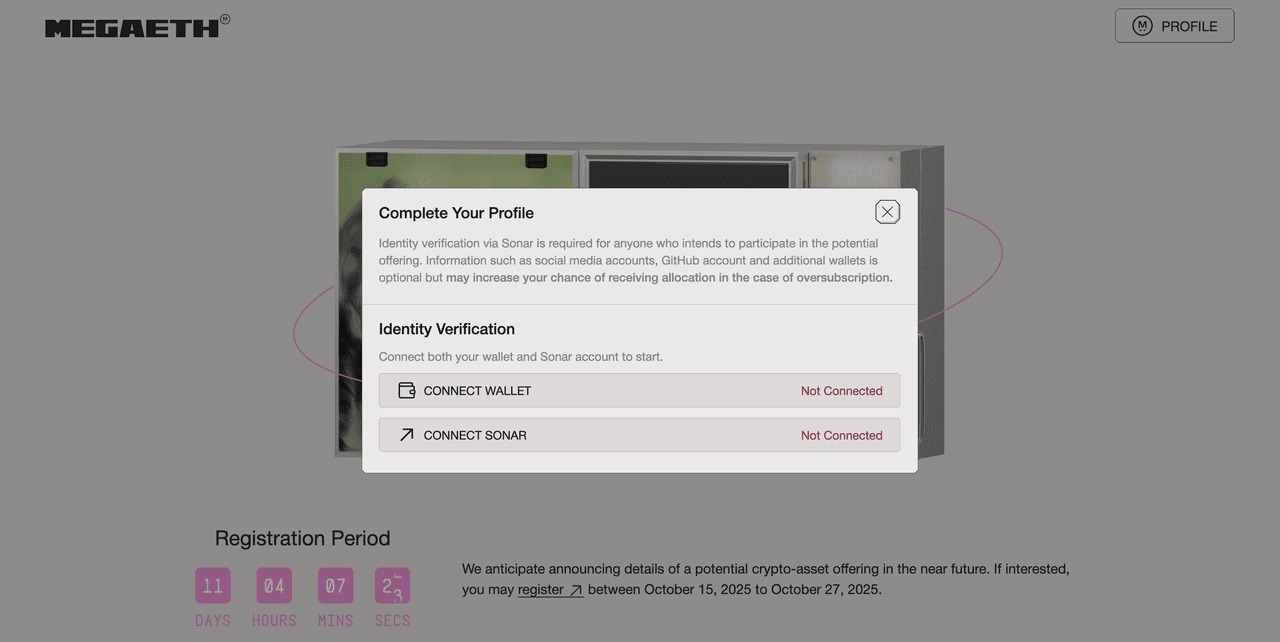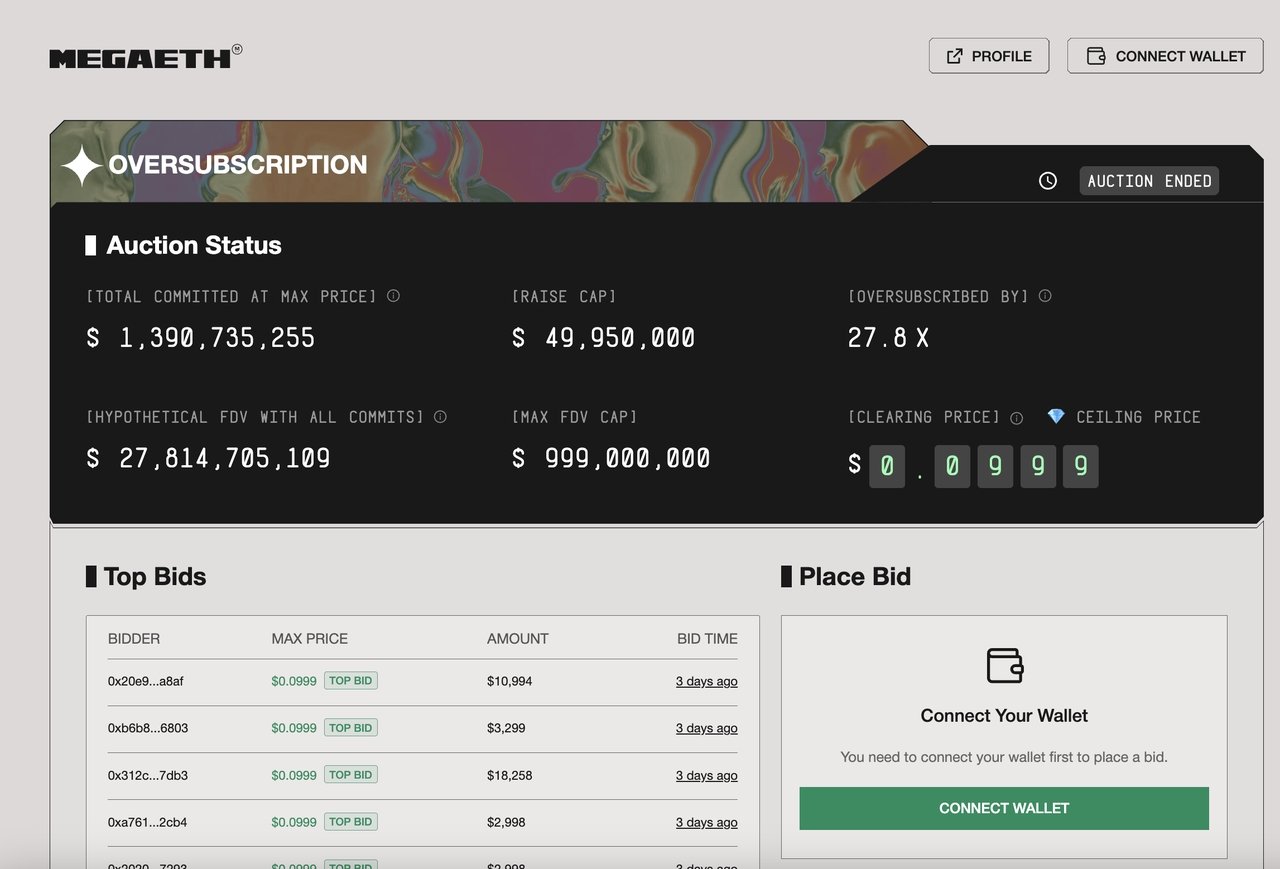MegaETH, a next-generation
Layer-2 built on Ethereum, opened ICO registration on Cobie’s Sonar platform from October 15 to 27, 2025, followed by a 72-hour public token sale from October 27 to 30, 2025 that raised $450 million out of $1.39 billion in total bids, oversubscribed by 27.8×.
Backed by
Vitalik Buterin, Joseph Lubin, and Dragonfly Capital, MegaETH aims to bring real-time blockchain performance to Ethereum. The network targets 100,000 transactions per second with sub-millisecond latency, making it one of the fastest and most anticipated Layer-2 solutions in 2025. Its goal is to combine Web2-level speed with Ethereum security, positioning MegaETH as a major contender in the next wave of Layer-2 innovation.
What Is MegaETH Ethereum Layer-2 and How Does It Work?
MegaETH is a next-generation Ethereum Layer-2 network designed to make blockchain interactions feel as fast as the internet. While most networks take seconds to confirm transactions, MegaETH targets speeds of over 100,000 transactions per second with block times as short as 10 milliseconds.
By processing transactions within milliseconds, it removes the usual waiting time for trades, swaps, or on-chain gameplay. For developers, this enables real-time applications that were previously impossible on slower networks.
Fully compatible with
Ethereum, MegaETH lets users connect with familiar wallets and developers deploy existing smart contracts without major changes. It positions itself as the first “real-time blockchain,” bridging the gap between today’s Web3 experience and the speed of traditional Web2 applications.
Core Advantages of MegaETH
• Fast L2 Confirmation: Transactions are processed and displayed within milliseconds, providing near-instant feedback for users
• Secure L1 Settlement: Final confirmation and security are anchored to Ethereum’s Layer-1 network
• Low Fees: Optimized design keeps gas costs far below Ethereum mainnet
• EVM Compatibility: Works seamlessly with existing Ethereum tools and dApps
• Scalable for Builders: Ideal for high-frequency
DeFi, gaming, and real-time social applications
• Strong Backing: Supported by Vitalik Buterin, Dragonfly Capital, and Joseph Lubin
MegaETH ($MEGA) Tokenomics Overview
The $MEGA token serves as the native asset of the MegaETH Layer-2 network, powering transaction fees, staking, governance, and ecosystem incentives. Designed to align incentives between users, validators, and developers, $MEGA fuels the network’s real-time economy and KPI-based reward system.
MEGA Token Supply and Allocation
Source: MegaETH X (Twitter)
Total Supply: 10,000,000,000 MEGA
• KPI Staking – 53.3%, 5,330,000,000 MEGA
• VC Allocation – 14.7%, 1,470,000,000 MEGA
• Team and Advisors – 9.5%, 950,000,000 MEGA
• Foundation / Ecosystem Reserve – 7.5%, 750,000,000 MEGA
• Echo Round – 5%, 500,000,000 MEGA
• Fluffle Round – 5%, 500,000,000 MEGA
• Public Sale (Sonar) – 2.5%, 250,000,000 MEGA
• Mainnet Bonus Campaign – 2.5%, 250,000,000 MEGA
Vesting and Rewards
• Public sale tokens distributed at TGE (January 2026)
• Optional 1-year lockup with 10% discount for long-term holders
• Team tokens: 1-year cliff followed by 3-year linear vesting
• KPI Staking Rewards: Released based on measurable on-chain metrics, not fixed time schedules
The $MEGA token introduces a KPI-based emission model that ties token releases to network adoption, decentralization, and performance milestones. As these goals are achieved, new tokens are unlocked and distributed to stakers, aligning rewards with sustainable ecosystem growth.
MegaETH ICO: Public Token Sale Raises $450M from $1.39B in Bids
The MegaETH ICO marked the project’s highly anticipated public token sale, giving retail participants early access to the $MEGA token ahead of its mainnet launch. Conducted on Cobie’s Sonar platform from October 27 to 30, 2025, the sale attracted overwhelming demand, with $1.39 billion in total bids and $450 million raised, an oversubscription of 27.8×.
Following the registration period from October 15 to 27, eligible users were able to place bids through a 72-hour English auction. The sale offered 5% of total MEGA supply, with allocations determined through a weighted and bimodal system prioritizing key contributors and community members.
Unlike previous private and community rounds, the ICO was open to the public, marking MegaETH’s transition from a developer-led testnet to a community-driven ecosystem. The project aims to use the proceeds to expand validator infrastructure, incentivize early users, and accelerate mainnet readiness ahead of MEGA’s expected trading debut in January 2026.
When Was the MegaETH ICO and Who Could Participate?
• Registration period: October 15–27, 2025
• Public sale date: October 27–30, 2025
• Clearing price: $0.0999 per MEGA
• Total bids: $1.39 billion
• Amount raised: $450 million (oversubscribed by 27.8×)
Who Is Eligible for the $MEGA Presale
Anyone who completes registration and passes KYC verification on Sonar by Echo during the registration window will be eligible to participate. The sale is open globally, except in restricted jurisdictions as defined by the platform’s compliance policy.
How to Participate in the MegaETH ICO
The MegaETH ICO is conducted through Sonar by Echo, the same platform used for previous high-profile launches such as Plasma (XPL).
Step 1: Go to MegaETH’s Offering Registration Page
Step 2: Register on Sonar by Echo
Create or log in to your Sonar account and complete KYC verification during the registration period (October 15–27, 2025).
Step 3: Wait for Token Sale Confirmation
After registration closes, Sonar will notify approved users about the confirmed sale date, allocation size, and accepted payment currencies.
Step 4: Participate in the MegaETH Token Sale
Connect your wallet and verify your registration on Sonar by Echo to place your bid at
sale.megaeth.com
How to Bid:
1. Verify your identity and wallet address.
2. Set your max token price ($0.0001–$0.0999) and enter your USDT amount ($2,650–$186,282).
3. Optional: choose a 1-year lock-up for a 10% discount (required for U.S. users).
4. Submit your bid. You can later adjust your price or add funds before the sale ends.
5. Bidding lasts 72 hours from Oct 27-30, 2025; final allocations go to bids at or above the clearing price ($0.0999).
6. If oversubscribed, allocations will consider profile activity, community engagement, and lock-up selection.
Make sure your Sonar profile is complete before the sale closes to improve your allocation chance.
Step 5: Claim Your $MEGA Token
Once you have successfully placed your bid, your allocation details will be displayed on the official token sale page at
sale.megaeth.com. You can view your bid status, allocated amount, and any refundable balance directly through the platform once the sale concludes.
Will There Be a $MEGA Airdrop?
Yes. MegaETH has confirmed that an airdrop-style distribution is part of its long-term token plan, primarily through The Fluffle NFT program and the bonus campaign linked to the public sale on Sonar by Echo. The Fluffle collection, consisting of 10,000 soulbound NFTs (two sets of 5,000), represents about 5% of total $MEGA supply and rewards early contributors, Mega Mafia teams, and active community members.
The public sale (October 27–30, 2025) and the bonus campaign (December 2025–January 2026) are also major components of early token distribution. The campaign will reward the top 5,000 participants with up to 2× their original allocation, depending on mainnet activity and staking participation.
When Could MegaETH Airdrop Launch?
While no separate airdrop date has been announced, token distribution and trading are scheduled for January 2026, coinciding with the mainnet launch and TGE. Early participants, including Fluffle NFT holders, testnet users, and public sale contributors, are most likely to be included in future reward rounds.
The airdrop and KPI-based emissions are expected to evolve into long-term incentive mechanisms that link $MEGA token unlocks directly to measurable network performance and community engagement.
Risks and Considerations Before Participating in the MegaETH ICO
While MegaETH’s public sale has drawn strong attention, participants should evaluate several project-specific risks before joining.
1. Unconfirmed token details: The team has not yet released the final tokenomics, including total supply, sale amount, and vesting schedule. Without these details, it is difficult to assess valuation or potential dilution.
2. Development and performance risk: MegaETH’s “real-time blockchain” claims remain in testing. The network’s ability to sustain 100,000 TPS and 10 ms block times under real mainnet conditions has not yet been proven.
3. Sale and listing uncertainty: The ICO timeline, token price, and post-sale liquidity have not been finalized. There is no guarantee that tokens will be listed immediately or supported by major exchanges at launch.
4. Regulatory and jurisdictional limits: Participation eligibility may vary by region. Users in restricted countries or without successful KYC verification on Sonar by Echo will not be able to join.
5. Security and verification risk: As excitement builds around the sale, fake registration sites or phishing campaigns are likely to appear. Only use links shared through MegaETH’s verified channels to avoid scams or data theft.
Conclusion
While the project’s performance and decentralization model will be tested only after launch, MegaETH’s approach to performance-linked emissions, Fluffle NFT distribution, and community-based incentives suggests a long-term vision built on measurable growth rather than short-term speculation.
If MegaETH can deliver on its technical goals and maintain transparency through its rollout, it may set a new benchmark for Layer-2 scalability and real-time blockchain infrastructure within the Ethereum ecosystem.
Related Reading






